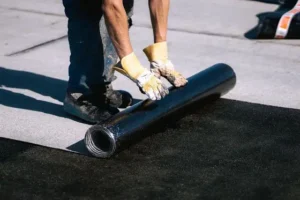With the advancement of science and technology, various new types of waterproof membranes continue to emerge. However, elastomer-modified bitumen waterproof membranes (commonly known as SBS waterproof membranes) consistently maintain a leading position in market demand. This is mainly due to their wide applicability, ease of installation, stable material performance, and excellent cost-effectiveness. SBS Waterproof Membranes are widely used in various parts of building waterproofing projects. Today, I’ll take you through the application of SBS waterproof membranes in roofing waterproofing works.
To understand how to use the material properly, it is essential first to be familiar with the relevant national standards. Below, I will outline the construction procedures and regulatory requirements to clarify the process. Let’s begin by reviewing the regulations on design and construction of roofing waterproofing as specified in the Roofing Engineering Technical Code (GB50345-2012).

01 Waterproofing Grade Requirements
The waterproofing grade is determined based on the building type, importance, and functional requirements.
-
Grade I waterproofing requires two waterproof layers.
-
Grade II waterproofing requires one waterproof layer.
The waterproof layers should be installed on the water-exposed side, i.e., above the roof structural layer.

02 Performance Specifications
According to Elastomer-Modified Bitumen Waterproof Membrane Standard (GB18242-2008), polyester-based (PY) SBS waterproof membranes are divided into Type I and Type II.
For polyester felt (PY) SBS membranes, the nominal thicknesses available are 3mm, 4mm, and 5mm.

The Roofing Engineering Technical Code (GB50345-2012) states that for ordinary Grade I waterproofing, the thickness of polyester-based (PY) membrane should not be less than 3mm. Therefore, a double layer of SBS membranes with 3mm + 3mm thickness meets the Grade I waterproofing requirement. Correspondingly, a single 4mm thick SBS membrane can satisfy Grade II waterproofing standards.
For green roofs (planted roofs), the upper waterproof layer must be a root-resistant membrane with added chemical root inhibitors. According to Root-Resistant Waterproof Membrane for Green Roofs Standard (GB/T35468-2017), the minimum thickness for SBS root-resistant membranes is 4mm—1mm thicker than ordinary waterproof membranes.
The Grade I waterproofing method for green roofs is to use a double-layer SBS membrane with 3mm thickness for the bottom layer (ordinary SBS membrane) and 4mm thickness for the top layer (root-resistant membrane).
Construction and Installation Procedures
Once the waterproof membrane rolls arrive on site, how should they be “seamed” together during installation?
Before waterproofing, the substrate must be cleaned thoroughly to ensure it is clean and dry. Then, a primer is sprayed on the substrate to ensure strong adhesion between the waterproof membrane and the substrate.
Suitable primers include petroleum asphalt cold primer or rubber-modified asphalt cold adhesive diluted solution.
After applying the primer, additional membrane layers must be installed at waterproof weak points such as eaves gutters, junctions between gutters and roof, and intersections between roof planes and vertical surfaces.
The Roofing Engineering Technical Code (GB50345-2012) requires that SBS membrane additional layers be at least 3mm thick and 250mm wide on each side (total 500mm width). A 1-meter-wide, 3mm-thick membrane split down the middle perfectly covers two additional layers.
SBS waterproof membranes are installed using a hot-melt method: the membrane surface is heated with a torch, and once molten, it is immediately adhered to the substrate or underlying membrane. Air is expelled from between layers, and rollers are used to press and bond firmly.
Large-Area Waterproofing
After completing the additional layers, the main waterproofing can proceed. When laying membrane over multiple roof spans, follow the principles of installing from far to near and from high to low. For single-span roofs, installation should proceed from the lowest point to the highest point (against water flow direction). Since the membrane width is only 1 meter, overlapping seams between membranes are necessary to fully cover the roof.
The Roofing Engineering Technical Code (GB50345-2012) requires that for hot-melt SBS membrane installation, overlap width must be at least 100mm. Overlap seams should be rolled to squeeze out molten modified asphalt adhesive, with an ideal overflow width of about 8mm.
For Grade I waterproofing, double layers are required. The second layer must be installed in the same direction as the first, with staggered short edge overlaps of at least 500mm and staggered long edge overlaps of at least one-third the membrane width. This prevents seam overlapping and reduces the risk of leaks.
Testing
After construction, water spray or ponding tests must be conducted. For ponding tests, all voids must be sealed tightly, and water retention should last for no less than 24 hours
📞 Get in Touch with Our Experts Today – Let’s Build Something Waterproof, Together!
-
- Phone: +86 138 6365 6701
- Email: Huafengwaterproof@gmail.com
- WhatsApp: +86 138 6365 6701






